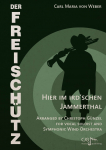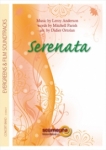Komponist:
Calvino, Giuseppe Besetzung:
Blasorchester
Genre:
Konzertstück • Originalwerk Produktart:
Partitur • Stimmensatz The TitleRituals, whether to do with religious, magical or amorous aspects, have always aroused the attention and interest of composers, for whom they are an immense and fascinating source of inspiration and mystery. One famous example is the ''Rite of Spring'', the celebrated ballet by Igor Stravinskij, in which a cruel barbaric ritual is performed to celebrate the magic of spring. There are many other such examples in the musical literature, including various compositions for symphonic band. In composing this piece, Giuseppe Calvino drew inspiration from the various types of rituals, especially African, in which a remarkable variety of percussion instruments beat the time of the dance rhythms, each instrument regarded as possessing poignant magical powers. The work starts with a slow introduction portraying the darkness of the night and preparations for the ceremony. It continues with a frantic group ritual leading up to the dramatic moment of the sacrifice. This marks the beginning of a frenzied dance in a crescendo of excitement, eventually breaking into the powerful solo by the percussion instruments that announces the final stage of the ritual. First performance: ''Mid EUROPE 2005'' - Schladming (A) - 16/7/2005 - Grande Banda Rappresentativa della Federazione Corpi Bandistici della Provincia di Trento - conducted by Marco Bazzoli.COMPOSITIONAL NOTESThe entire work is based on the G Phrygian mode (G-Ab-Bb-C-D-Eb-F-G), with the ''tritone'' as its predominant, harmonic and melodic interval. The main compositional material, which consists of the notes G-Ab-C-D, is used both horizontally and vertically throughout the piece. The ''Lento misterioso'' is based on two long dominant-tonic pedals, with the use of polychords (measures 21, 22 and 23) and of the Percussion instruments to provide ''colours'' and effects. The ''Allegro con fuoco'' starts with an ''upturned pyramid'' of the basic notes (D-C-Ab-G), repeated alternately and in sequence by the Saxophones/Horns and by the Clarinets/Trombones/Euphoniums, while the Trumpets, Flutes and Basses (including the Bassoons and Bass Clarinet) play 8-measure rhythmic-melodic ostinatos. In measure 71 the Oboe introduces the theme by the Clarinets and Euphonium I (measure 81), with a preview in G of the first 9 notes of the ''countertheme'' which appears in measure 126, played in D. The Oboes and Trombone I, ''light'' timbre instruments, then answer the theme played by the ''dark'' timbre instruments (measures 94 onwards and 99 onwards). In measures 106 onwards and 111 onwards, the answers by Bassoon I and Euphonium I, in two fragments, anticipate the first notes of the ''subject'' of the canon, which starts in measure 121 (Presto), with a single mutation in measure 113 (G-Ab-F-G, instead of G-Ab-G-F-G). The ''Drammatico'' (measure 116) is an alternation of the opening subject and answer of the ''head'' of the canon while the Clarinets play the G Phrygian mode, doubling at the inferior 4th. In measure 120 the Djembè announces the beginning of the ''Presto'', composed in the form of a canon, with the Bassoon playing the 15-measure Antecedente (Dux), the first 5 measures of which constitute the ''subject'' and the next 10 the ''countertheme'' (with imitation of the ''subject'' by augmentation, retrograde motion and contrary motion). The imitation continues in the various octaves until measure 151 which is the starting point for 3 successive expositions of the ''subject'' on a single continuous imitation of the ''countertheme'', with the Timpani and Bass Drum sounding in the pauses. An 8-measure solo by the Percussion section (measure 173 onwards) introduces the final stage of the ritual, in which the thematic material used throughout the piece is reworked. The piece ends with a sequence in unison on the melodic ''tritone'' interval, culminating in a brutal crescendo and a deafening collective shout.
Folgende Optionen können gewählt werden um diese Ausgabe zu konfigurieren:




